Diastasis recti abdominis (DRA) has become a hot topic as more and more women's fitness professionals advertise programs that promise to prevent or fix the condition. While it is a terrifying thought for most, DRA is a reality for up to 70% of pregnant and postpartum women (Hakan, 2018).
These programs have introduced several strong opinions into the discussion including avoiding crunches and the prone position or abstaining from core exercises during pregnancy and postpartum.
These ideas are widely circulated which has influenced the perception of exercise during the pre- and postnatal period. Unfortunately, many of the common recommendations for addressing DRA are based on grains of truth or best guesses and do not take into consideration much of the recent research.
This article provides a brief overview of the common misconceptions, a synthesis of the latest studies, and recommendations for helping clients beat the statistics and avoid diastasis.
It is also an important topic to explore if you are training (or want to train) female clientele as a Women's Fitness Specialist.
What is diastasis recti?
Diastasis recti abdominis (DRA), commonly shortened to diastasis recti or diastasis, is the separation of the rectus abdominis down the linea alba. Though it can also occur in men who carry excess abdominal fat, the condition is most commonly associated with women during and after pregnancy as a result of hormonal shifts and the continual stress placed on the core from carrying a baby to term.
recent research on diastasis recti and crunches
The typical assessment for diastasis is performing a slight abdominal crunch while palpating with two fingers above and below the belly button to feel for a separation of the abdominal wall. A one finger width or smaller is normal, but anything larger than two fingertips is considered DRA.
In recent years, crunches have been considered off limits for pregnant and postpartum women. They have been criticized by many bloggers and fitness professionals citing possible strain on the spine as well as increased abdominal pressure. Instead of the crunch, clients have been encouraged to “draw in” their navel to their lower back or “suck in” their belly during exercise.
As with many recommendations, there is a bit of truth to these ideas. It is true that pulling on the neck can strain the spine (flexion itself does not), excessive intra-abdominal pressure should also be avoided, and it is best for the core muscles to stay engaged during physical activity.
Performing crunches correctly can help prevent D.R.A.
Recent studies have shown that the generalized advice that women frequently receive, without detailed guidance, can often do more harm than good -- especially for those with DRA. Crunches, or curl-ups as they are called in the scientific literature, are safe and effective for strengthening the core when performed correctly (Schoenfeld & Kolber, 2016). They also typically do not need to be avoided during pregnancy or postpartum as commonly suggested.
Whereas simply drawing in the belly toward the spine can increase pressure down the midline of the abdominals widening the inter-recti distance (IRD), also called “the gap.” (Mota, Pascoal, Carita, & Bo, 2015). In fact, many studies published in the past few years have reached the same conclusion, the drawing in maneuver adds to the strain on the linea alba, resulting in increased IRD, while the curl-up closes the gap. Science has proven that crunches and other common core exercises can be used to both prevent and treat DRA.
While it would be nice to end there, the human body is incredibly complex which means that issues like diastasis recti are rarely black and white. Even though crunches have been proven to be effective to strengthen the core and close the gap, a study using ultrasound technology showed that they may also distort the linea alba in people with DRA. However, when performed after engaging the transversus abdominis (TrA), the distortion was reduced or eliminated (Lee & Hodges, 2016).
This finding reinforces the idea that crunches are not inherently good or bad, but like most exercises, they must be taught and performed correctly to reap the benefits. While making subtle adjustments is necessary, many expectant and new mothers unnecessarily cease all core exercises in an effort to prevent DRA because of the confusion and controversy surrounding the topic. Preventing diastasis is far easier than attempting to fix the problem after it has occurred.
Allowing core muscles to atrophy for nine months (and then followed by several months postpartum) increases the chances of muscles separating under the strain of pregnancy and delivery. The conflicting advice does women a disservice because maintaining a strong core and healthy weight with exercise before, during, and after pregnancy is undoubtedly the best method to avoid DRA.
Deep breathing, stability balls,
There are a few additional points to consider when helping women prevent or heal diastasis. Since it is not typically advised for women to exercise flat on a hard surface after the first trimester, gentle crunches on a stability ball or a slightly inclined bench are convenient alternatives to the mat.
Core strength can also be accomplished by performing deep breathing exercises, pelvic tilts, planks, modified pushups and other bodyweight exercises that engage the abdominals. It is important to avoid deep twisting through the midsection and quick twisting movements like bicycle crunches that add additional stress to the already stretched abdominal wall during and soon after pregnancy.
Proper breathing is a critical component for keeping the core strong and avoiding excess strain. The Valsalva maneuver, holding the breath and bearing down commonly associated with crunches, heavy lifting, and other strenuous exercise, creates excess intra-abdominal pressure which can cause serious problems with the core and pelvic floor.
Exhaling on the exertion of any movement can alleviate pressure on the abdominals as well as the pelvic floor. Lastly, each exercise should begin with proper alignment to consistently reinforce good posture, promote hip stability, and correct muscle imbalances.
Avoiding excessive anterior pelvic tilt or “sway back” will lessen the strain on the abdominal wall and lower back. Mothers returning to exercise after giving birth should ease back into training with a focus on restoring neutral alignment as well as rehabilitating the core and pelvic floor rather than weight loss or intensity. Recent studies have shown that exercise, including curl-ups with an activated TrA, can help close the gap and increase core strength.
The research is now shifting more toward optimizing core function, alleviating pain, and improving quality of life. Successfully healing severe cases of diastasis continues to be a challenge which is why encouraging pregnant women and new moms to prevent DRA by maintaining a strong core and dispelling myths about pre- and postnatal exercise is essential.
Top 8 Exercises to Prevent Diastasis Recti:
Modified Crunch: Manually pulling rectus abdominis muscles together
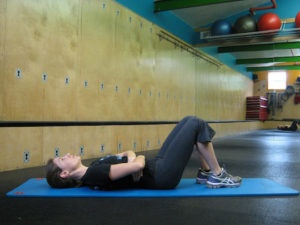
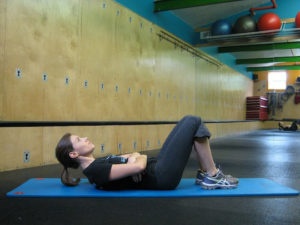
Lie on back with bent knees and feet flat on the floor. Use hands or wrap a towel or belly band around the waist to pull the abdominal muscles together. Inhale deeply to expand the belly. Slowly exhale while contracting the abdominals, pulling them inward, and raise head off the floor. Return to the starting position and repeat.
Pelvic Tilt with Crunch on Ball
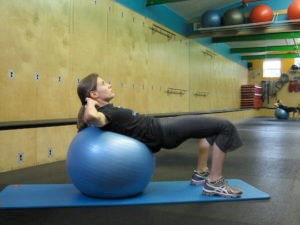
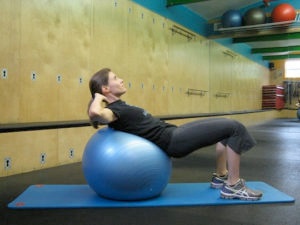
Start by sitting on a well-inflated stability ball, then slowly roll down until it fits comfortably on the lower back. Be sure the body feels balanced, placing the feet directly under the knees. Stabilize the neck by gently supporting the head. Exhale and roll shoulders slightly up off of the ball in a crunch. During the crunch, the hips press up and away from the ball while squeezing lower abdominals, glutes, and pelvic floor. Inhale and slowly return shoulders and hips to the start position. Be careful the ball does not slip out! This is a very short range of motion. Do not relax abdominals or stretch over the ball; the core should remain engaged throughout the exercise. If this is too complicated to start, just focus on the crunch without a pelvic tilt.
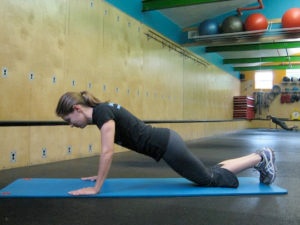
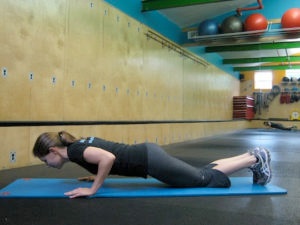
Start in a kneeling pushup position with the back/neck straight and core tight. Place hands in line with the chest, and wider than the shoulders. Slowly bend the elbows and lower toward the floor. Be sure not to sag the lower back down or raise hips too high. Press back up to starting position and exhale. If pushups hurt the wrists, they can be done on the fists/knuckles, using pushup handles, or grip dumbbells to keep wrists straight.
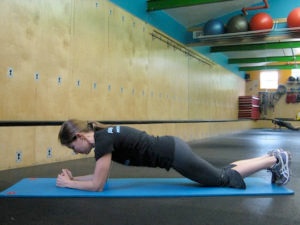
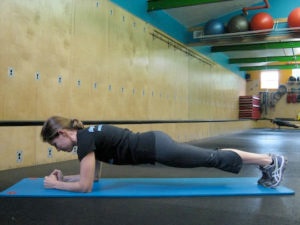
Lie in a prone position on forearms with elbows positioned under shoulders, on toes or kneeling. Draw abdominals in tight -- bracing the belly. While maintaining the abdominal contraction, tighten glutes, pelvic floor, and inner thighs, and hold body straight. Never sag the hips. Raise hips or take a break if needed. Form is more important than how long it is held. The core remains tight the whole time, and breathe steadily.
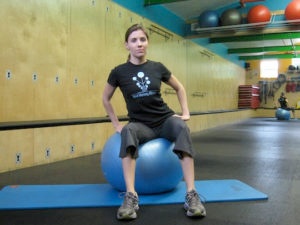
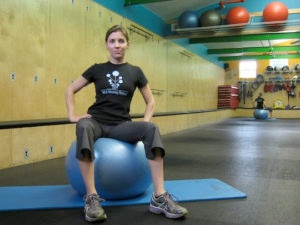
Sit on the ball with good posture. Move hips in small circles to the right. Try to use the core and not the legs. Then slowly move hips to the left. Then forward and back. Keep core tight and breathe normally.
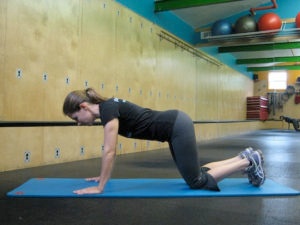
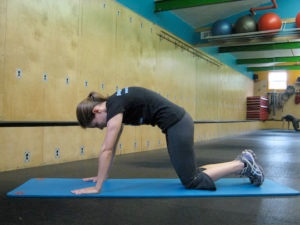
Start on all fours with hands aligned directly beneath shoulders, and knees directly beneath hips. Begin by drawing in the abs, slowly exhaling, and rounding spine toward the ceiling. Release the rounded spine and drop the belly toward the floor while relaxing the abdominal muscles. Repeat with each breath.
Opposite Arm and Leg Extension
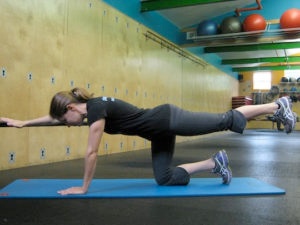
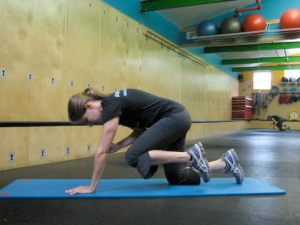
Begin on all fours with back straight, hips level, and core tight. Lift one leg straight behind, and the opposite arm directly in front. Reach and inhale. Bring knee in toward the elbow while squeezing the abs, round the back, and exhale. Complete repetitions on one side before switching.
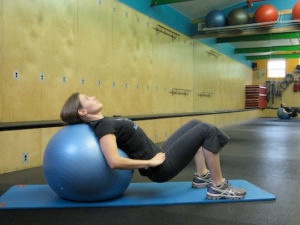
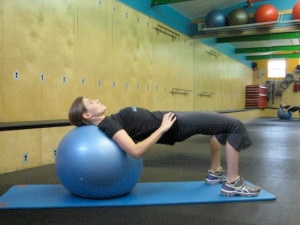
The head should rest comfortably on the ball with the neck in a supported, neutral position. Hips, knees, and ankles should be aligned at a 90-degree angle. Lower the hips toward the floor, and then lift the hips slowly.
If moving the hips is not comfortable on the lower back, simply hold the top position or try tucking the pelvis to lengthen lower back muscles. Keep the knees over the ankles, not in front of toes. The ball should not move during the exercise.
The science is conclusive that the safest and most effective strategy for preventing diastasis is with consistent physical activity, weight management, and core strengthening exercises (including crunches) throughout a healthy pregnancy and postpartum.
If you haven't already, consider becoming an expert in Women's Fitness, so you can use this reference to ease your clients' minds about diastasis recti.
Do you have a question about diastasis? Have you experienced DRA yourself or with a client?
Visit these links for blogs, CEUs and articles from NASM and AFAA:
- Squats for Pregnant Women
- Guide to a Strong Pelvic Floor
- NASM Women's Fitness Specialization
- Blog on Post-Partum Core Workouts
References:
Hakan, K. (2018). Umbilical Hernia Repair and Pregnancy: Before, during, after…. Frontiers in Surgery, 5(1).
Lee, D. & Hodges P. (2016). Behavior of the linea alba during a curl-up task in diastasis rectus abdominis: An observational study. Journal of Orthopaedic & Sports Physical Therapy, 46(7), 580-589.
Mota, P., Pascoal, A., Carita, A. & Bø, K. (2015). Inter-recti distance at rest, during abdominal crunch and drawing in exercises during pregnancy and postpartum. Physiotherapy, 101.
Schoenfeld, B. & Kolber, M. (2016). Abdominal Crunches Are/Are Not a Safe and Effective Exercise. Strength and Conditioning Journal, 38(1), 61-62.
















